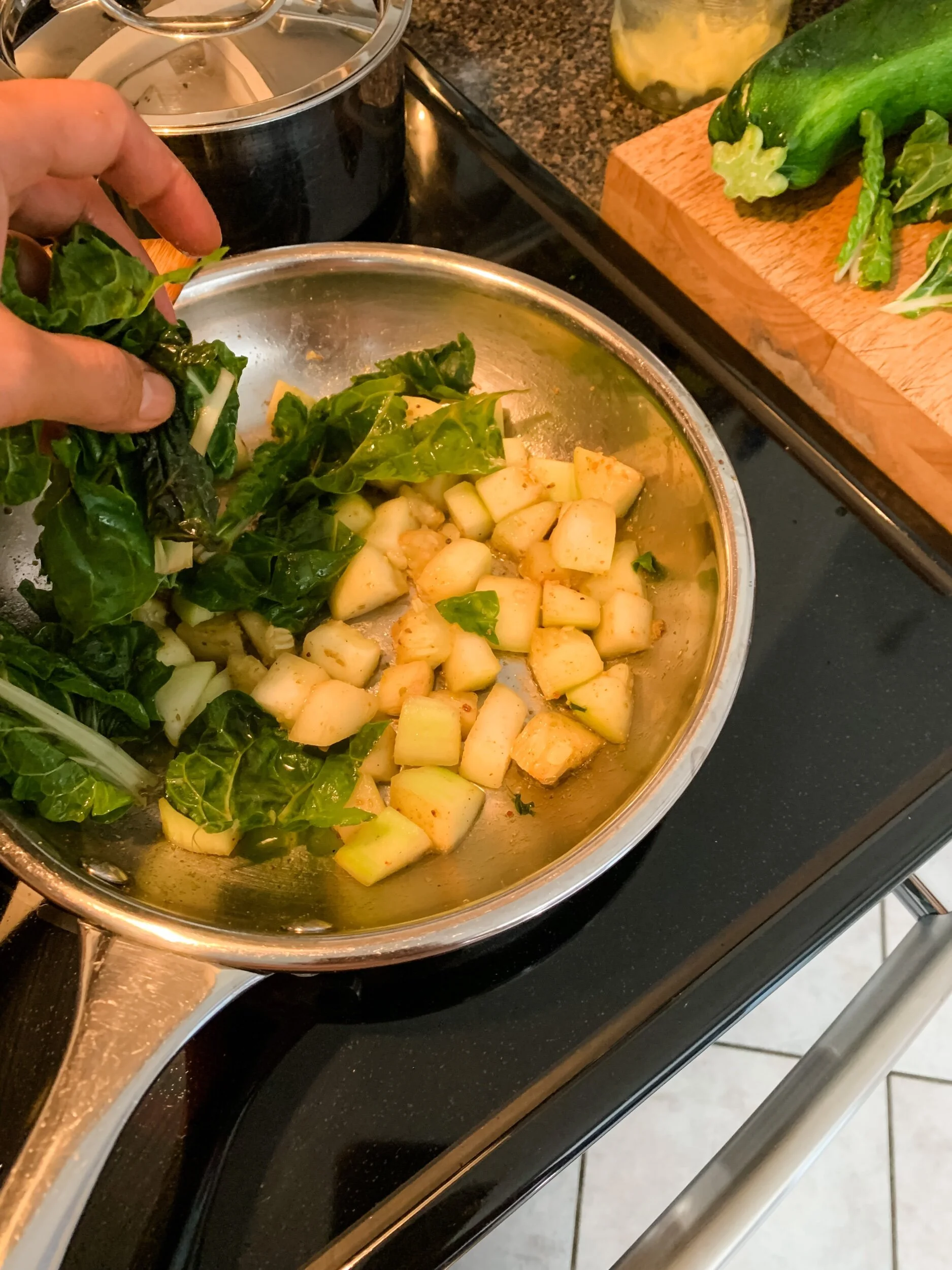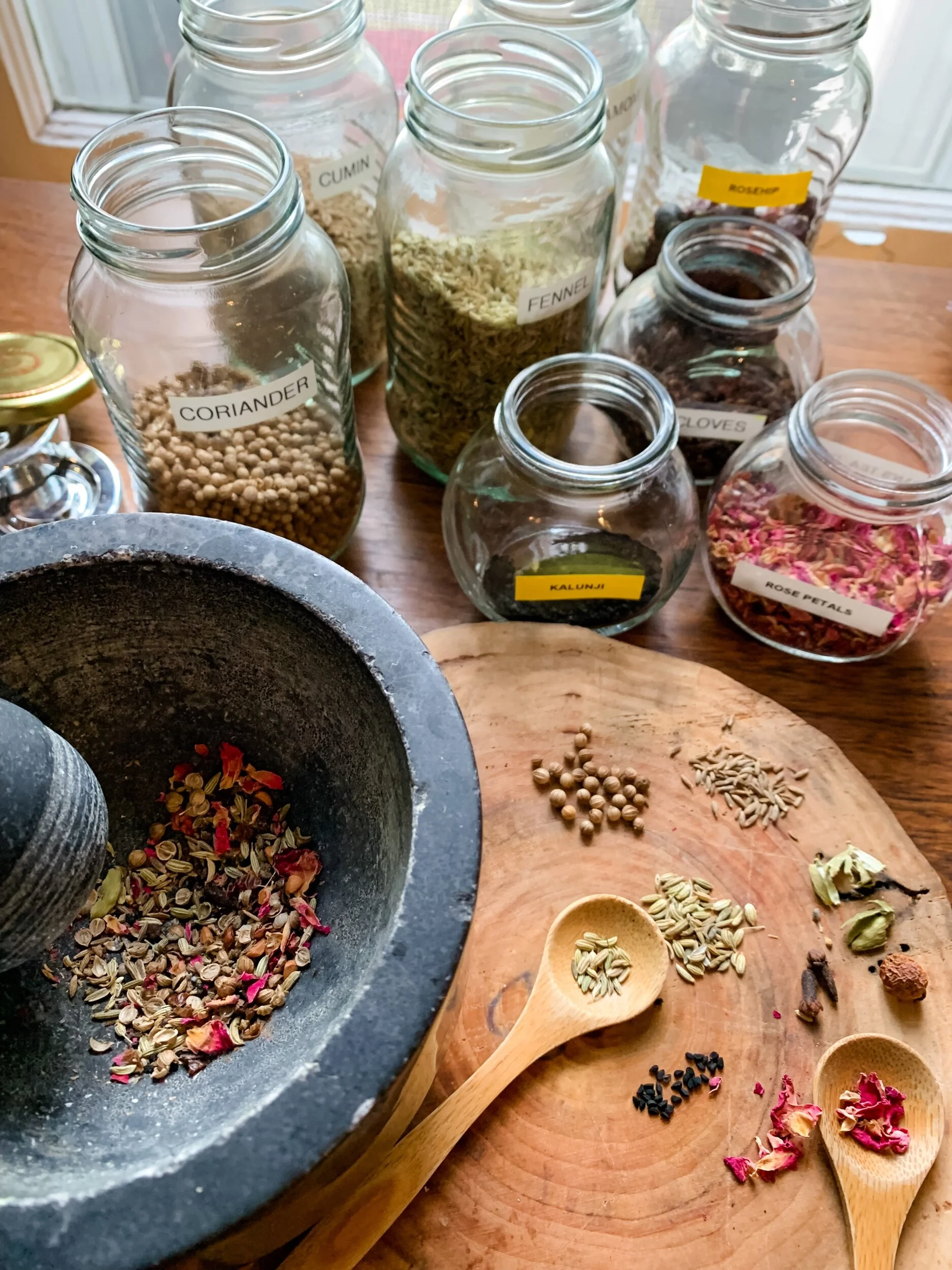Summer Spices
WELCOME TO MY BLOG! I’M EVANGELINE. I AM AN RMT AND HOLISTIC HEALTH COACH. I STARTED MY BLOG DURING COVID TO STAY CONNECTED TO MY CLIENTS AND SHARE MY LOVE OF COOKING HEALTHY, AYURVEDIC MEALS.
AYURVEDIC COOKING TAKES A BALANCED, HEALING APPROACH FOR YOUR DAILY COOKING NEEDS. YOU WILL FIND SIMPLE, EASY TO MAKE NOURISHING MEALS I HAVE MADE FOR MY FAMILY, WITH A DOSE OF AYURVEDA & YOGA WISDOM.
I put together some cooling spices to add to dinner the other night. It’s summer here and we could still feel the heat even later into that evening. In summertime, taking care of the fiery energy in you is a must this time of year. Adding spices that have a cooling, soothing quality will help take the edge off excess heat that easily accumulates in our physiology, especially during the summer.
Summer spice mix with paneer chunks, zucchini, carrot strips and Swiss chard.
Your fiery energy is identified in Ayurveda as pitta dosha, which has five sub-doshas found in the stomach (pachak pitta) , liver (ranjaka pitta), heart (sadhaka pitta), the eyes (alochoka pitta) and the skin ( bhrajaka pitta). Summer evenings are heavenly, but staying up late into the night unfortunately aggravates pitta dosha. Pitta energy dominates between the hours of 10am-2pm and 10pm-2am. This is the reason why having lunch around noon is the ideal time because your digestive fire is high during those hours. Avoiding the “hangry” phase is highly recommended to keep your pitta dosha balanced. In practice, I always recommend to clients to not skip or delays meals, and emphasized more so with pitta dominant clients and people prone to headaches and migraines. The liver is a pitta organ, and during lunch, when pitta energy dominates, your digestive juices are being secreted and looking for food to digest. If there is no food pitta dosha will get high. The liver filters your blood, and an aggravated liver makes “hot” blood, which can give rise to headaches. At night, staying up late aggravates the liver, disrupts your body’s natural functions and in the long term has adverse effects on your health.
Cooking with cooling spices and staying hydrated are some simple things you can do to balance your pitta, fiery energy. For a satisfying herbal water recipe, try this Hydrating Drink.
The calming, soothing, cooling qualities of the Summer Spice Mix is very balancing and helps keep your pitta dosha in check, especially during the summer. You’re going to love it!
Summer Zucchini and Swiss Chard
Sautéed in 1 tsp summer spice mix and ½ tsp ghee. Zucchini is a cooling vegetable, perfect during the summer.
Lauki squash is another cooling vegetable, similar to a zucchini, that I also cook with especially during spring detox.
Summer Spice Mix
3 tsps fennel seeds
3 tsps coriander seeds
½ tsp cardamom seeds (about 6 cardamom pods)
1 small rosehip
½ tsp rose petals
2 cloves
¼ tsp cumin seeds
¼ tsp kalunji seeds
Grind all together. Store in a glass jar away from heat and sunlight.
When cooking, toast lightly on a dry skillet ½ tsp - 1 tsp of the spice mix, then add some ghee or olive oil until the aroma is released. Toss in your vegetables or protein of choice.
Enjoy!
Ayurvedic Profile of Spices in the
Summer Spice Mix
Coriander- cooling, binds toxins and ushers them to the urinary channels
Cumin- opens the agni within the stomach
Cardamom- cooling quality; helps with protein metabolism
Rosehip- pacifies sadhaka pitta and opens the heart lotus
Cloves- opens up the channels without aggravating pitta dosha
Turmeric- “friend to the liver”, anti-inflammatory, antioxidant, anti-bacterial, anti-viral
Rose petals- pacifies sadhaka pitta; cooling to the body, and soothes the heart and mind
Kalunji- helps cool body heat
Fennel- cooling, balances the heat of pitta dosha
As with all things, including spices, more is not necessarily better, even if it is good for you. Ayurveda pays close attention to the therapeutic value of spices and food with the understanding of their gross and subtle qualities. According to Ayurveda, food (ahara) is the first of three sub-pillars. Rest (nidra) and right action in thought, word and deed (brahmacharya) are the other two. They function as a hierarchy. Food influences quality of sleep, and quality of sleep affects our mind and actions. Spices tie in with food, as they derive from plants, and each have their own unique therapeutic properties, as modern science is discovering.
On the wood board starting at 12 o’clock and clockwise: coriander seeds, cumin seeds, cardamom, rosehip, cloves, rose petals, kalunji seeds, fennel seeds
References
Vaidya R. K. Mishra- Notes from Shaka Vansiya Ayurveda Courses, Practicum, Conferences and Lectures 2003-2015



